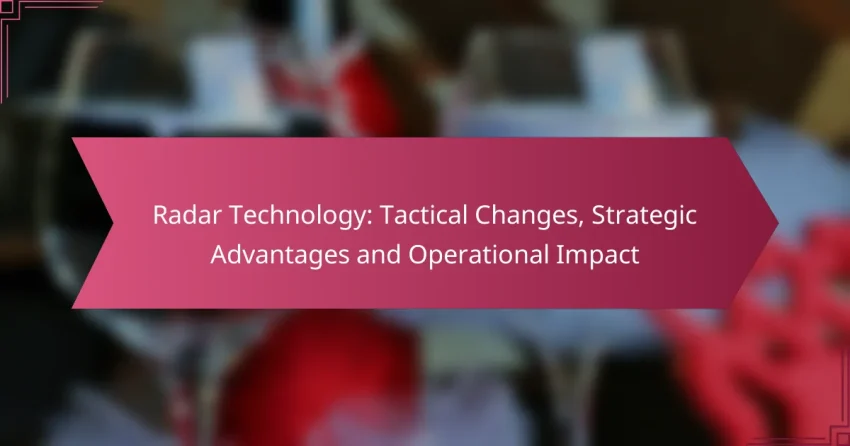Radar technology has undergone significant tactical changes that enhance detection capabilities and operational efficiency, allowing for better responses to dynamic environments and threats. By improving situational awareness and enabling real-time data analysis, radar systems provide strategic advantages that facilitate informed decision-making in both military and civilian applications.
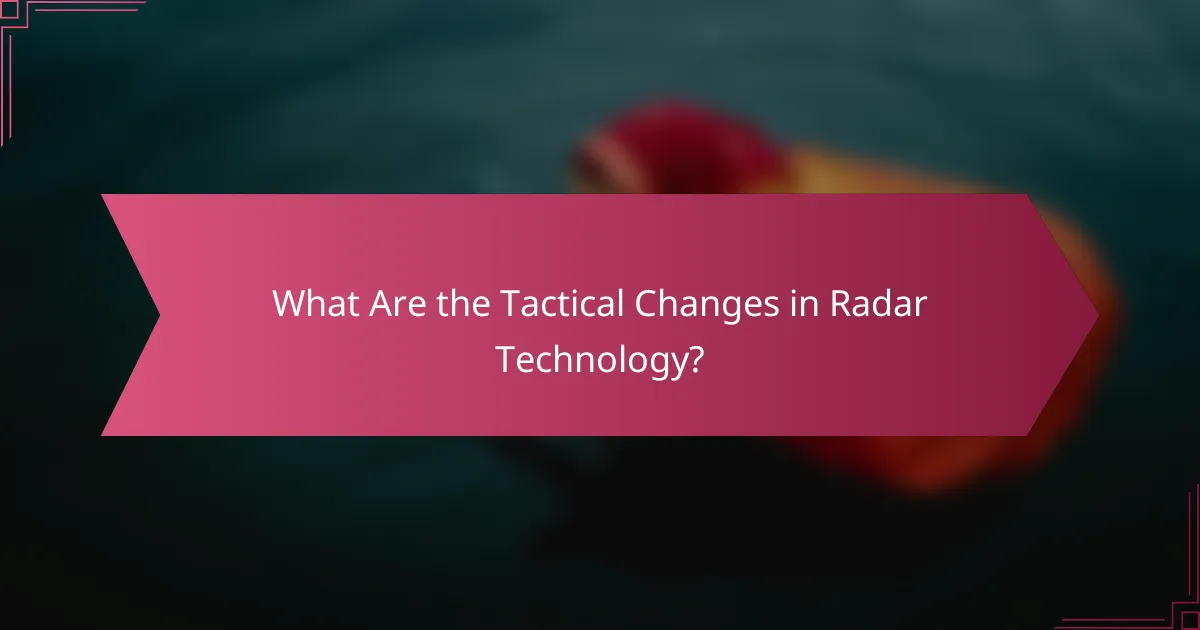
What Are the Tactical Changes in Radar Technology?
Tactical changes in radar technology focus on enhancing detection capabilities, improving operational efficiency, and integrating advanced technologies. These changes enable military and civilian applications to respond more effectively to dynamic environments and threats.
Advancements in Signal Processing
Recent advancements in signal processing have significantly improved radar performance. Techniques such as pulse compression and Doppler filtering allow for better target discrimination and clutter reduction, enhancing the radar’s ability to detect smaller or faster-moving objects.
These improvements enable radar systems to operate effectively in complex environments, such as urban areas or during adverse weather conditions, where traditional systems might struggle.
Integration with AI and Machine Learning
Integrating AI and machine learning into radar systems enhances their analytical capabilities. These technologies can process vast amounts of data in real-time, identifying patterns and making predictions about potential threats.
For example, AI algorithms can improve target classification and tracking accuracy, allowing operators to focus on relevant information and make quicker decisions in tactical situations.
Improved Resolution and Range
Modern radar systems now offer improved resolution and range, allowing for more detailed imaging of targets at greater distances. This is achieved through advancements in antenna design and signal processing techniques.
Higher resolution enables better identification of objects, which is crucial for applications such as air traffic control and military surveillance, where distinguishing between friend and foe is vital.
Adaptive Beamforming Techniques
Adaptive beamforming techniques allow radar systems to dynamically adjust their focus based on the operational environment. This capability enhances target detection and tracking by minimizing interference from unwanted signals.
By optimizing the radar’s beam shape and direction in real-time, operators can achieve better performance in cluttered environments, improving overall situational awareness.
Miniaturization of Radar Systems
The miniaturization of radar systems has made them more versatile and easier to deploy. Smaller radar units can be integrated into various platforms, including drones and vehicles, expanding their operational reach.
This trend allows for the development of portable radar systems that can be quickly set up in the field, providing tactical advantages in reconnaissance and surveillance missions.
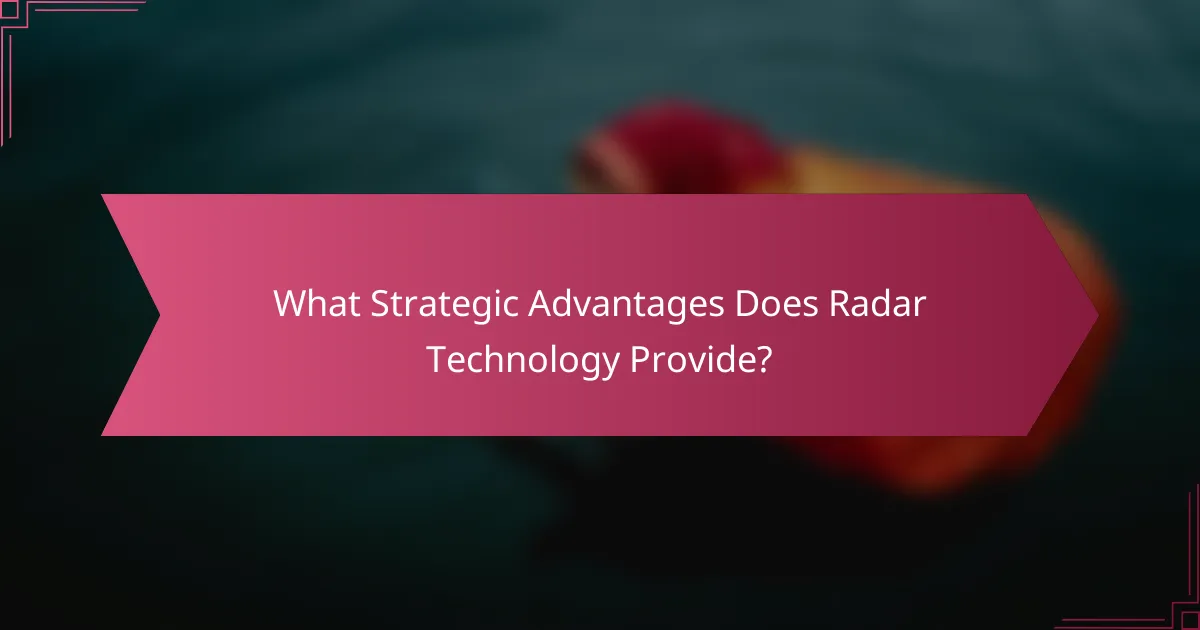
What Strategic Advantages Does Radar Technology Provide?
Radar technology offers significant strategic advantages by enhancing detection capabilities, improving situational awareness, and enabling real-time data analysis. These benefits lead to more informed decision-making and operational efficiency in various military and civilian applications.
Enhanced Situational Awareness
Enhanced situational awareness is a critical advantage of radar technology, allowing operators to monitor and interpret their environment effectively. By providing continuous surveillance, radar systems can detect and track multiple objects simultaneously, offering a comprehensive view of the operational area.
This capability is especially valuable in military contexts, where understanding the positions of friendly and enemy forces can dictate tactical decisions. For instance, a radar system can identify incoming threats, enabling timely responses to potential attacks.
Improved Target Detection and Tracking
Radar technology significantly improves target detection and tracking by utilizing radio waves to identify objects at various distances and speeds. Modern radar systems can differentiate between various types of targets, such as aircraft, vehicles, and maritime vessels, enhancing operational effectiveness.
For example, advanced radar systems can track fast-moving objects with high precision, allowing for better engagement strategies. This capability is crucial for air defense systems, where identifying and intercepting hostile aircraft quickly can be a matter of national security.
Real-time Data Analysis Capabilities
Real-time data analysis is a key feature of radar technology that enables immediate decision-making based on current conditions. Radar systems can process incoming data rapidly, providing operators with actionable insights without delay.
This capability allows for dynamic adjustments in strategy during operations. For instance, if a radar detects a sudden change in enemy movements, commanders can quickly adapt their tactics to counteract potential threats effectively.
Cost-Effectiveness in Operations
Cost-effectiveness is a significant advantage of radar technology, as it reduces the need for extensive manpower and resources. By automating detection and tracking processes, radar systems can operate efficiently with fewer personnel, lowering operational costs.
Moreover, the long lifespan and low maintenance requirements of modern radar systems contribute to their overall value. Investing in radar technology can lead to substantial savings in the long run, especially for military organizations that require reliable surveillance capabilities.
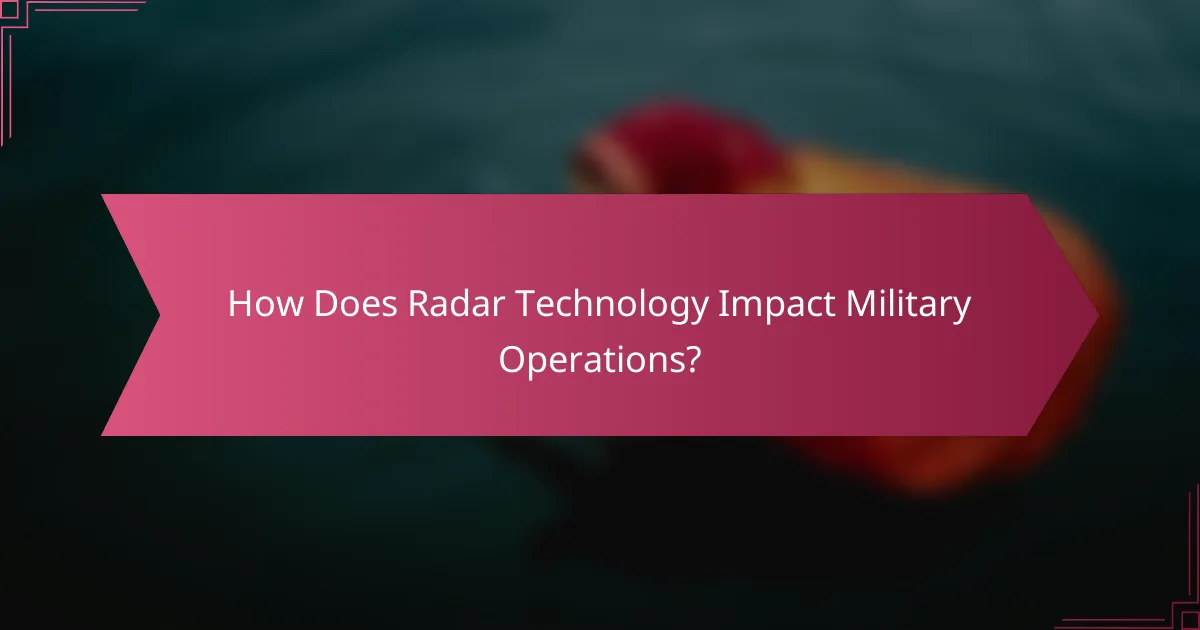
How Does Radar Technology Impact Military Operations?
Radar technology significantly enhances military operations by providing real-time situational awareness, improving target detection, and facilitating effective decision-making. Its integration into various military systems leads to more efficient and coordinated efforts on the battlefield.
Increased Operational Efficiency
Radar systems streamline military operations by enabling faster identification of threats and targets. This efficiency allows forces to allocate resources more effectively, reducing response times to potential threats.
For instance, modern radar can track multiple targets simultaneously, which is crucial for air defense systems. This capability ensures that military units can maintain a strategic advantage by responding swiftly to enemy movements.
Support for Joint Operations
Radar technology plays a vital role in joint operations by enhancing interoperability among different branches of the military. It allows for seamless communication and data sharing, which is essential for coordinated attacks and defense strategies.
Using standardized radar systems enables ground, air, and naval forces to operate together more effectively. For example, a radar-equipped naval vessel can provide real-time data to air support units, improving overall mission success rates.
Reduction in Casualties
By improving target identification and tracking, radar technology helps reduce casualties during military operations. Accurate detection minimizes the risk of friendly fire incidents and enhances the safety of troops on the ground.
Additionally, radar systems can provide early warning of incoming threats, allowing forces to take evasive actions. This proactive approach significantly lowers the likelihood of casualties in combat scenarios.
Enhanced Communication Systems
Radar technology contributes to enhanced communication systems within military operations. Advanced radar systems often integrate with communication networks, facilitating the rapid exchange of critical information.
For example, data from radar can be transmitted to command centers, allowing for real-time updates on battlefield conditions. This integration ensures that commanders have access to the most current information, enabling informed decision-making during operations.
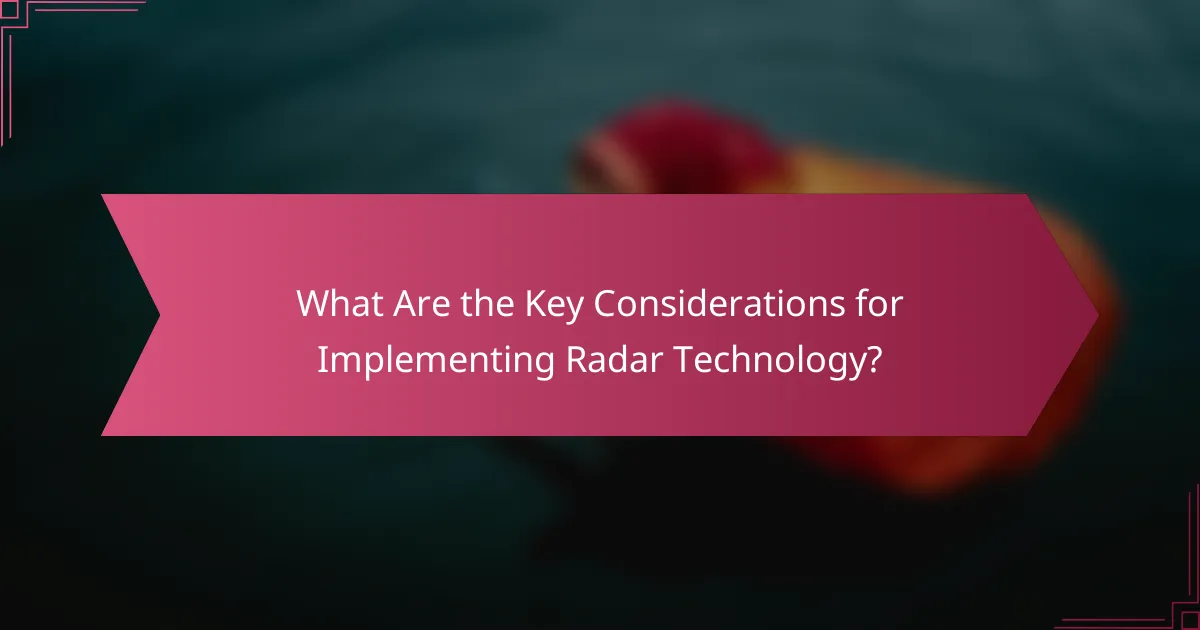
What Are the Key Considerations for Implementing Radar Technology?
Implementing radar technology requires careful evaluation of several key factors, including budget constraints, system integration, and training needs. Each consideration plays a crucial role in ensuring the effective deployment and operation of radar systems.
Budget Constraints
Budget constraints are a primary consideration when implementing radar technology. Organizations must assess not only the initial purchase cost but also ongoing maintenance, upgrades, and operational expenses. It’s essential to allocate funds wisely to avoid overspending while ensuring the system meets operational requirements.
When budgeting for radar systems, consider the total cost of ownership, which includes installation, training, and potential future enhancements. Organizations may also explore financing options or government grants to offset costs, especially in defense or public safety sectors.
Integration with Existing Systems
Successful integration of radar technology with existing systems is vital for maximizing its effectiveness. This involves ensuring compatibility with current hardware and software platforms, as well as aligning operational protocols. A thorough assessment of existing infrastructure can help identify potential integration challenges.
Consider conducting a gap analysis to determine what modifications or upgrades are necessary for seamless integration. Engaging with vendors early in the process can provide insights into compatibility issues and help streamline the implementation process.
Training and Skill Development
Effective training and skill development are critical for personnel operating radar systems. Users must understand both the technical aspects of the technology and its operational applications. Comprehensive training programs can enhance user confidence and improve system performance.
Organizations should develop tailored training sessions that cover both theoretical knowledge and practical skills. Regular refresher courses and hands-on workshops can help maintain proficiency and adapt to evolving radar technologies. Additionally, fostering a culture of continuous learning can empower staff to stay updated on advancements in radar technology.
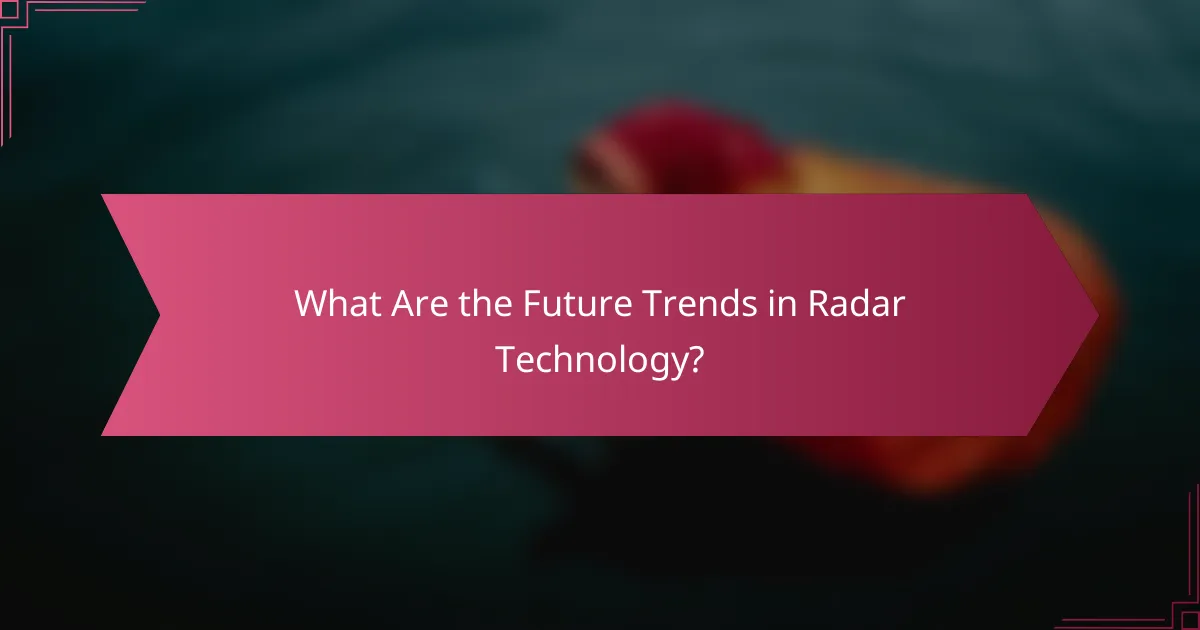
What Are the Future Trends in Radar Technology?
The future of radar technology is shaped by innovations such as quantum radar and enhanced integration with 5G networks. These advancements promise to improve detection capabilities, reduce interference, and enhance data transmission speeds, significantly impacting military and civilian applications.
Development of Quantum Radar
Quantum radar represents a groundbreaking shift in radar technology, utilizing principles of quantum mechanics to detect objects with greater precision and reduced vulnerability to jamming. This technology exploits entangled photons, allowing for enhanced sensitivity and the ability to detect stealthy targets that traditional radar may miss.
One of the key advantages of quantum radar is its potential to operate effectively in environments with heavy electronic interference. For instance, while conventional radar systems may struggle in urban settings, quantum radar could maintain operational effectiveness, making it invaluable for military operations and urban surveillance.
Advancements in 5G Integration
The integration of radar technology with 5G networks is set to revolutionize data sharing and processing capabilities. By leveraging the high-speed and low-latency features of 5G, radar systems can transmit data in real-time, enhancing situational awareness and decision-making in various applications, from defense to traffic management.
For example, combining radar with 5G can facilitate advanced vehicle-to-everything (V2X) communication, improving traffic flow and safety. However, organizations must consider the challenges of ensuring cybersecurity and managing the complexity of integrating these technologies effectively.
